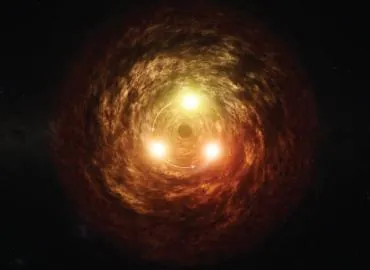
Groundbreaking Discovery: First Ever Mid-Infrared Flare Detected from Milky Way's Supermassive Black Hole!
2025-01-14
Author: William
Introduction
In a remarkable breakthrough for astrophysics, an international team of researchers, including notable figures such as Assistant Professor Bart Ripperda and graduate student Braden Gail from the Canadian Institute for Theoretical Astrophysics, has made history by detecting a mid-infrared flare from the supermassive black hole at the center of our Milky Way Galaxy, known as Sagittarius A* (Sgr A*). This event marks the first time mid-infrared emissions have been captured from this cosmic giant, which boasts a mass estimated at approximately 4 million times that of our Sun.
Background on Sagittarius A*
Since the early 1990s, Sgr A* has intrigued scientists with its periodic flares observable across a range of wavelengths. These flares provide essential insights into how the black hole emits energy and the dynamics of its surrounding environment. Previous studies gained significant traction, with groundbreaking imaging from the Event Horizon Telescope in 2022, yet a crucial void remained in understanding the mid-infrared emissions—until now.
Details of the Detected Flare
The detected flare lasted around 40 minutes, aligning with the duration of other recorded flares in near-infrared and X-ray wavelengths. Mid-infrared light occupies a unique position in the electromagnetic spectrum, allowing researchers to penetrate the dust that traditionally obscures observations of black hole flares. This new capability encourages further exploration of this elusive area of black hole dynamics.
Research Insights and Simulations
"The flare observed at the center of the Milky Way with JWST was so well-monitored that it allows us not only to deduce properties of the radiation but also to gain insights about the electrons orbiting the black hole that emit the photons. The data is profound, allowing us to validate our theories via simulations," expressed Bart Ripperda enthusiastically.
Mechanisms Behind the Flares
Although the precise mechanism behind these flares remains a subject of research, many simulations propose that interactions between tangled magnetic field lines within the turbulent accretion disk surrounding the black hole lead to significant energy releases. When magnetic field lines intertwine, they can reconnect, resulting in bursts of energy that manifest as synchrotron radiation, emitted by accelerated electrons moving at nearly the speed of light.
Evolution of Sgr A* Flares
Highlighting the rapid evolution of Sgr A* flares, Joseph Michail—one of the lead authors and a National Science Foundation Astronomy and Astrophysics Postdoctoral Fellow—stated, "Over two decades, we've gained insights into the radio and near-infrared spectra. However, the linkage between these observations has always been ambiguous. The mid-infrared data fills a vital gap in our understanding."
Contributions of Simulations
Braden Gail added a technical edge by noting how his simulations run on a Canadian supercomputer provide essential data about how supermassive black holes accumulate material, processes known to sculpt entire galaxies. The vital mid-infrared observation, combined with existing data from near-infrared, X-ray, and radio wavelengths, provides the complete picture necessary for grasping the complexities of energy emissions from these enigmatic cosmic bodies.
Announcement and Future Directions
The monumental findings were announced during a press conference at the 245th meeting of the American Astronomical Society in National Harbor, Maryland, and these groundbreaking observations have been recognized for publication in the prestigious Astrophysical Journal Letters.
Conclusion
This historic milestone not only enhances our understanding of Sgr A* but also paves the way for future research that could unravel the mysteries of supermassive black holes and their role in galaxy formation. Stay tuned as scientists delve deeper into the cosmos’ most intriguing phenomena!



 Brasil (PT)
Brasil (PT)
 Canada (EN)
Canada (EN)
 Chile (ES)
Chile (ES)
 Česko (CS)
Česko (CS)
 대한민국 (KO)
대한민국 (KO)
 España (ES)
España (ES)
 France (FR)
France (FR)
 Hong Kong (EN)
Hong Kong (EN)
 Italia (IT)
Italia (IT)
 日本 (JA)
日本 (JA)
 Magyarország (HU)
Magyarország (HU)
 Norge (NO)
Norge (NO)
 Polska (PL)
Polska (PL)
 Schweiz (DE)
Schweiz (DE)
 Singapore (EN)
Singapore (EN)
 Sverige (SV)
Sverige (SV)
 Suomi (FI)
Suomi (FI)
 Türkiye (TR)
Türkiye (TR)
 الإمارات العربية المتحدة (AR)
الإمارات العربية المتحدة (AR)